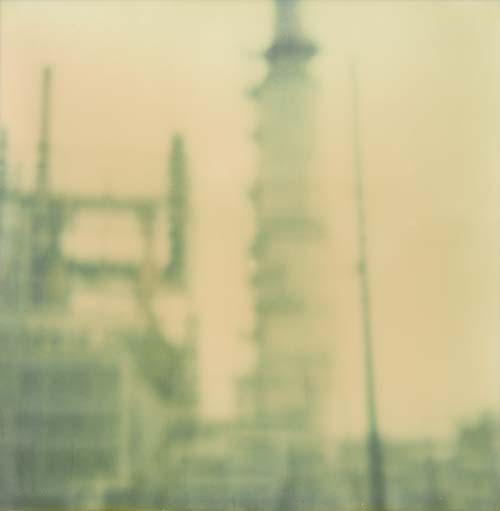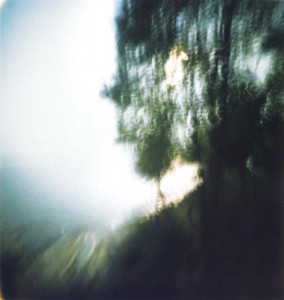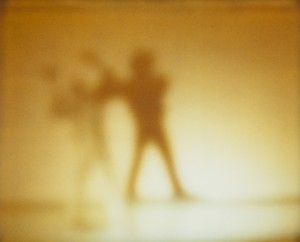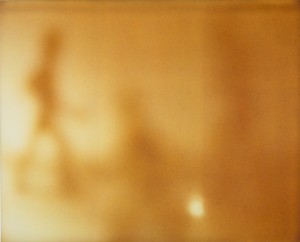The Last Polaroid Artist?
Christopher Bonanos
Will Susan Mikula become the world’s last Polaroid artist? It seems likely. Although a couple of companies still make instant film, the original stuff manufactured by Polaroid is nearing the end of its useful life, and this weird old material for making pictures, once ubiquitous, is fast disappearing from the world. The final batches of film from Polaroid’s factories reached their use-by date in October 2009, and instant film that’s past its prime is less like an industrial product than it is like, say, a piece of fruit: It goes bad. After a year or two, the colors shift to a pinkish-yellow. Later on, everything turns greenish-brown. Then the chemistry starts to dry up or leak, and eventually the photos won’t come out at all. Although enthusiasts are husbanding their little refrigerated stashes of film, less and less of it works with each passing year. By conventional standards, it’s passing the point of no return.

American Device #45
But Susan doesn’t work by those conventions. Her medium of choice is badly expired film. The bilious khaki cast of a six-years-gone Polaroid frame is exactly what she’s looking for. It is, to her, the perfect way to summon the poisoned, acidic landscape of the scenes she favors—often, parts of the American landscape that once hummed with industry and no longer do. The smokestacks we sometimes see in her images are no longer filling the air with sulfurous fumes, but in her photographs we see it nonetheless. I know of nobody else who works so precisely with film that’s so far gone. When every other serious photographer has given up on Polaroid film, I suspect Susan will still be trying to squeeze a few frames out of one final pack that turned up in the back of someone’s refrigerator. A line of enthusiasts that began with Ansel Adams—who in 1949 became Polaroid’s first artistic ambassador, and stayed in the role for the rest of his life—will almost surely wind down with her. Tidily enough Adams often shot pristine American landscapes, unsullied by humanity, whereas Mikula goes for places that were despoiled, then left for dead.
Nearly all artists believe in marrying medium and subject matter. After all, as the critic Jerry Saltz has noted, a pretty good definition of art itself is “embedding thought into material.” That’s profoundly true for Susan’s work. The disused factories and barbed-wire locales she frequently shoots were the places that supplied every American home with consumer goods. They cranked out shoes and appliances and TV sets by the ton—not to mention cameras and film. Polaroid, for its part, made the lion’s share of its stuff in Massachusetts, where Mikula herself lives. In other words, she’s using a nearly dead product of American manufacturing, one that in its time touched almost every American life, to document the dying majesty of American manufacturing itself.
Moreover, she does it in the gnarliest possible way. Aged instant film doesn’t just produce weird colors: it’s also unpredictable. When she goes out to shoot, she might have 120 frames’ worth of scavenged old film in her bag, and if 30 of them don’t work—as is entirely possible—her day can be severely curtailed. (Ninety pictures: with a digital camera, you’d bang that many shots off in five minutes.) Nor does she choose places to photograph that are especially accessible. Big disused industrial sites are often under guard, and security officers tend not to react well to people with cameras. In other words, she can spend all day getting to the right spot with the right light at the right moment and still lose the shot because of a dodgy old pack of film. And if she does actually get it, one uniformed guard who gets huffy at her presence—and confiscates her photos—can undo everything.

started Early – Took my Dog #7
Those elements of chance in her work are, I think, particularly appropriate to our age. We live in a time when most recorded media are astoundingly good and rock-solid reliable. (Your smartphone contains a better video camera than the ones used to televise the Super Bowl a generation ago, and its components are the size of a pinto bean.) When everyone has the ability to make sharp, bright, near-flawless photos all day long, some of us crave something a little less “perfect.” Old and eccentric media get more interesting again; so do things that don’t come out the same every time. I’m reminded of the dance pieces choreographed by Merce Cunningham in which dice rolls indicate the structure and steps to come. A performer, preparing to go onstage in one of these works, doesn’t entirely know what he or she will end up doing, and so it is with Susan’s photography: Some pictures may work very differently from others shot under the same conditions. Luck (as the cliché goes) is the residue of design, and she’s stacked the deck in her favor. But she has deliberately left certain things outside her control.
All these particular headaches—let’s call them “challenges”—make Susan’s photos feel that much more precious. Polaroid prints, unlike digital images or even conventional analog pictures, are not only photographs but objects. Because they have no separate negatives, each is a singular three-dimensional thing, hard to copy and as unique as a sculpture carved by hand. That goes double when the process of shooting them can be so iffy. Sometimes great Polaroid photographs are described as lucky moments, and a lot of them certainly are, but that’s not usually what’s going on here. (As Susan has said, “People say, that’s a happy accident. No, that took me five years to make.”) That the medium can be so unpredictable brings an extra level of poignance and power when everything works.
Admittedly, Susan does not often exhibit the original Polaroid photographs she shoots, though she keeps them all. At her gallery shows, she displays prints, for which she takes extreme pains to reproduce the original color fastidiously. (No Photoshop messing-around for her, either.) What you see on the walls of her exhibitions is as close to the Polaroid original as can possibly be; it’s just a bit bigger, with the added texture that comes with printing on fine art paper. This time out, she is using Awagami Bizan, a mulberry paper handmade by a Japanese firm that’s been in business for centuries. In the past, she’s printed on paper made by Crane & Company, another Massachusetts industrial behemoth—one that literally supports the American economy, because Crane also makes every sheet of currency paper for the United States of America. (If you want to go looking for a neat irony about photographs of bankrupt factories, it’s there for the taking.) Her new work is mounted on aluminum sheet stock and framed in heavy black steel, too: more old-style industry on view.

u.X #24
The photography in this series once again looks at the American landscape, in her customary style—undead Polaroid palette, extremely soft focus, most images nearly in silhouette, with little fine detail to be seen—but her subject material has shifted. This time, we see human figures in scenarios that Susan herself has constructed. They’re mostly built with toys, often playthings from Mikula’s childhood, but what we see is anything but coziness or nostalgia or kitsch. The scenes these figures enact are mysterious, and it’s pretty clear that they’re not happy moments. Whatever child we imagine at play is thinking about dark things. Mikula is rooting around in the chaotic moments at the edge of what we can see: She’s said that she was thinking about the shadows burned into buildings by the blast at Hiroshima, or the fallen, frozen figure casts at Pompeii. A few of her photographs hint at people fleeing something, urgently. We don’t really know what’s going on, but we can infer a lot, and things are not all right. Once again, form intertwines with message: a dying medium is documenting lives in trouble.

u.X #34
That said, they are indistinct enough that we can project our own feelings into these frames. In the world’s worst places—war zones, blighted neighborhoods, refugee camps—people create ad hoc communities, grabbing hold of one another. In a few of these frames, we see that too. Groups form and separate; figures reach toward each other. Through the haze, there are glimmers of renewal. “You find,” Susan says, “a connection to your own emotional landscape. I hope.”
Christopher Bonanos
New York, 2013
Christopher Bonanos is a writer and editor at New York magazine and a contributor to The New York Times and Slate. He is a frequent lecturer on the history of Polaroid and author of the book “Instant: The Story of Polaroid.”
